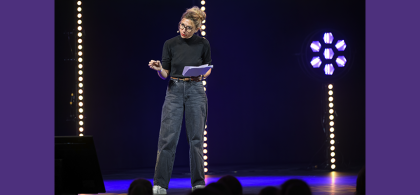
At NEOMA, a course to unleash student creativity
How a professor reimagined learning to foster creative and entrepreneurial minds. A look back at the teaching experience of Dr. Linda Mitrojorgji, Assistant Professor of Strategy and Entrepreneurship at NEOMA.
The stakes. Developing creative ideas and turning them into projects—this was the ambition of Dr. Linda Mitrojorgji, Assistant Professor of Strategy and Entrepreneurship at NEOMA, for her course “From Idea to Business Value.” Over the span of 30 hours, the professor invited students from the very first sessions to challenge conventional wisdom. She dismantles certain biases that can block imagination. “No, creativity is not the exclusive domain of a lucky few,” she explains. “And no, ideas don’t just fall from the sky—they’re more often born from an accumulation of experiences, observations, and connections.”
A challenge. To anchor learning in real life, Linda presents a business challenge each year. In 2023, it was La Poste Group that submitted a problem related to “digital inclusion and new uses.” Students conducted surveys, held interviews, and observed in the field… before proposing innovative solutions. “This challenge acts as a common thread throughout the entire learning journey. It provides context for learning creativity and innovation tools and gives meaning to each step of the process.”
Effective methods. From the outset, Linda made sure to establish “psychological safety”—an environment where students could express ideas without fear of judgment, and where no single participant would dominate. For example, the “brainwriting” technique is a useful tool for allowing everyone to jot down their ideas before a group discussion—ideal for the more reserved. The professor also used the ideation method SCAMPER* or co-creation with Generative AI to help students think outside the box, as well as drawing, collage, and story- telling. She encourages diversity within groups—a great way to broaden and enrich perspectives.
A mix of teaching approaches. Once the groundwork was laid, it was time for practice. Theoretical content and key concepts could be retrieved at any time from the school’s online platform. Classroom time was centered around collaborative group work on idea generation, idea selection, and prototyping. “It was important that students could collaborate in class in a structured environment with constant guidance,” she emphasizes. The NEOMA professor structured the course by using the five key stages of the “design thinking” method – empathize, define, ideate, prototype and test – to guide students in tackling the La Poste challenge.
Results. For the professor, the results were sometimes surprising: TikTok campaigns, stop/go animations with their own hand-drawings , role-play skits filmed by students. “Their creativity didn’t stop at the idea—it also came through in how they presented it,” she marvels. Many students also became aware of their own creativity. As for the professor: “It’s more tiring than delivering a lecture, but infinitely more rewarding” she confides.
*SCAMPER stands for seven action verbs: Substitute, Combine, Adapt, Modify, Put to another use, Eliminate, and Reverse (or Reorganize).*



